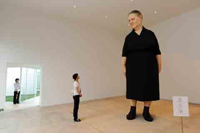 Modern art project befuddles uncool Japanese town
Modern art project befuddles uncool Japanese town By Harumi Ozawa / AFP
TOWADA, Japan, Aug 8, 2008 (AFP) - Sitting in her quiet shoe store on the main shopping street of this far northern Japanese town, 79-year-old Yoshiko Sugawara wonders what exactly the huge red object was supposed to be.
"Some people say it's a bee, but what do you think? Is it an ant?" she asked in the strongly accented local dialect. "I haven't even gone to see what's inside the new museum."
Sugawara's store -- where hundreds of pairs of shoes are on sale, all of them out of style -- is one of the few retailers still in business on the main drag of Towada near the northern tip of Japan's main island of Honshu.
Unlike the many other Japanese regional cities that never fully recovered from recession in the 1990s, Towada is trying out a novel solution -- turning the downtown section of the declining city into a giant hub of modern art.
The Towada Art Centre opened in April as the main part of a five-year urban project, which is being built at a cost of nearly 2.7 billion yen (25.24 million dollars).
Next to the glass-walled museum -- itself an odd sight in provincial Japan -- lies the imposing red object that so befuddled Sugawara. It is entitled "aTTa" and is the work of Japanese artist Noboru Tsubaki.
The museum exhibits contemporary works commissioned from 21 artists including Yoko Ono, who contributed the "Wish Tree" installation, and Australia's Ron Mueck, known for his hyperrealistic sculptures.
Despite the famous names from the world of contemporary art, many residents of Towada remain cynical -- especially because of the unadvertised source of funding for the project.
"The city created the museum with grants subsidised by the nuclear facilities up there," said Mitsuaki Tsubo, 53, as he sat in a park playing cards with his neighbours.
"The project has nothing to do with local residents like us," he said. "Some people in the city administration are simply doing what they feel like doing."
Towada, with a population of 67,000, is adjacent to Rokkasho, the hub of Japan's nuclear industry including a highly controversial plant that reprocesses used nuclear fuel.
Japan, which has virtually no oil or gas resources, has been pressing to increase the production of nuclear power, which accounts for about one-third of the nation's needs, despite protests by residents near the plants.
The nuclear business brings 600 million yen (5.6 million dollars) a year to Towada, which is free to spend it as it pleases, said Kazuyasu Nakanowatari, assistant director of the Towada Art Centre.
"We are aware of the criticism that the city spends money for the sake of spending," he said, adding that profits from the art project so far do not make up for the cost. "But we believe that this is an investment in the future, increasing people's awareness of arts and culture."
In reality, only 19 percent of the nearly 1,700 visitors to the museum on a sample week were from Towada, Nakanowatari said.
"The quality is far more superb than we had expected," said Hiraku Saito, 55, visiting Towada from northern Japan's largest city of Sendai as he strolled through the museum with his daughter.
"I like visiting art museums. I just went to Tokyo the other day to cruise the museums," he said. "I hear many visitors here are from outside the province but I hope people in the city realise what a great asset they have."
But shoe retailer Sugawara feels that the city needs better welfare services more than art.
"Towada is a city of farmers. The economy here has been bad because farmers cannot make enough money," she said.
"The situation got even worse since the time of Koizumi," she said, bitterly referring to Junichiro Koizumi, prime minister for five years until 2006.
The cost-cutting reformist was one of the most popular leaders in Japan's modern history on the back of support from urban areas, but he was criticised in rural areas for slashing public services.
Koizumi's reforms have also contributed to the steady infiltration of large supermarket chains across regional cities, where small shops have been on the decline in the downtown areas.
"I'm sure the artwork is great and making the main street a wonderful place," Sugawara said.
"But old folks here are wondering why the city spends so much money on such things," she said.
 Modern art project befuddles uncool Japanese town
Modern art project befuddles uncool Japanese town